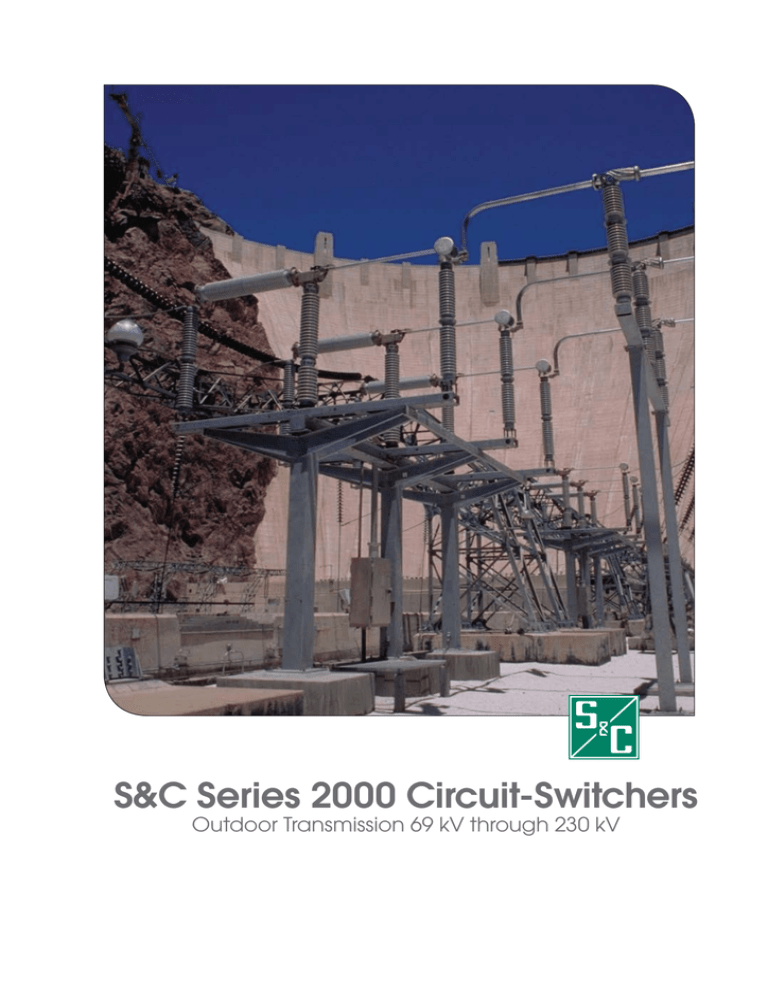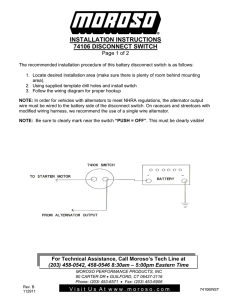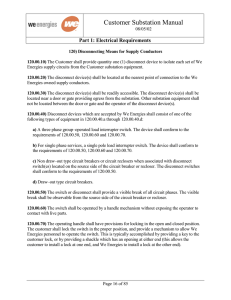Descriptive Bulletin 716-30
advertisement

S&C Series 2000 Circuit-Switchers Outdoor Transmission 69 kV through 230 kV Why do power users choose the Series 2000 Circuit-Switcher over any other circuit-switcher? Series 2000 Circuit-Switcher advances the state of circuit-switcher technology by bringing you breakthroughs including: s Reliable, economical switching and protection— for transformers, single-shunt capacitor banks, lineconnected and testing-connected shunt reactors, lines, and cables. s High interrupting ratings—25-kA or 40-kA interrupting rating for 69-kV through 138-kV units, and 20-kA for 161-kV and 230-kV units—allowing application on a wide variety of systems. s A family of models for all station layouts—with or without integral disconnects. Ideal for new or retrofit applications. Now available with pedestal heights up to 20 feet! s Superior reliability and economy—simple, straightforward design with fewer parts means lower purchase cost . . . lower operating cost. s Maintenance-free interrupters—hermetically sealed to eliminate the hassle and expense of field filling with SF6 . . . ensuring long, trouble-free life. s Complete factory-assembly and checkout—preengineered modular construction assures quality . . . dramatically reduces installation time. s Superb mechanical and electrical operating life— proven in the test lab and in the field, backed by a full 5-year warranty. s Select models meet high seismic requirements of IEEE Standard 693—critically important in high-seismic qualification level areas. s Available with optional features including a selection of key interlocks, grounding switch, and bypass accessory. 138-kV Series 2000 Circuit-Switcher Model 2010—With Horizontal Interrupters and Vertical-Break Disconnect. 2 S&C ELECTRIC COMPANY SERIES 2000 CIRCUIT-SWITCHER INTERRUPTING RATINGS Application Class Maximum Amperes, Interrupting, RMS Symmetrical Qualifications Parallel Switching – 1200/2000J Load Dropping – 1200/2000J Transformer Switching and Protection Primary faults Fault Interrupting 69 kV through 138 kV 25 000/40 000BD=Q 161 kV and 230 kV 20 000B@F Secondary faults 4000H; Internal faults—see both primary and secondary faults, above Load Splitting (Parallel or Loop Switching) Line Switching Load Dropping – 1200/2000J 400 161 kV 320 Load Splitting (Parallel or Loop Switching) – 1200/2000J Load Dropping – 1200/2000J 69 kV through 138 kV 400 161 kV 320 Cable Dropping (Charging Current) Fault Interrupting Single Shunt Capacitor-Bank Switching and Protection Bank Current Switching 69 kV through 138 kV 25 000BD= 161 kV 20 000B@F Grounded capacitor banks applied on solidly grounded systems only, through 138 kV 400 Ungrounded capacitor banks through 115 kV – Fault Interrupting Series Reactor Switching Shunt Reactor Switching and Protection (LineConnected or TertiaryConnected Reactors) 1200/2000J 69 kV through 138 kV Line Dropping Cable Switching and Protection – 400 25 000BD= Refer to the nearest S&C Sales Office Reactor Current Switching Grounded reactors applied on solidly grounded systems only, through 138 kV 600 Ungrounded reactors, 69 kV only – Fault Interrupting 600 25 000BD= S&C BankGuard PLUS™ Controls, described and listed in S&C @ Rating is based on transient-recovery-voltage parameters defined in Publications 1011-30 and 1011-31, have the sensitivity to detect the first faulted unit in a capacitor bank, or to respond promptly to a shorted-turns fault in a shunt reactor—but with the discrimination to disregard system and bank unbalances, as well as spurious transients. F At temperatures between -30°C and -35°C, the fault interrupting For applications on parallel (“back-to-back”) capacitor banks, refer to the nearest S&C Sales Office. Series 2000 Circuit-Switcher can close, carry, and interrupt the magnetizing current of the protected transformer. The interrupting ratings shown are applicable for the following duty cycles: O or CO. J Depending upon continuous current rating of Circuit-Switcher. B Tripping of Series 2000 Circuit-Switcher must be coordinated with source-side protective equipment for short-circuit currents in excess of this value. D Rating is based on transient-recovery-voltage parameters defined in Table IIA of IEC Standard 56: 1987 for Series 2000 Circuit-Switchers rated 69 kV, and Table IID of IEC Standard 56: 1987 for Series 2000 Circuit-Switchers rated 115 kV through 138 kV. = At temperatures between -30°=°C and -40°C, Circuit-Switchers with 25,000 ampere fault interrupting rating are rated 20,000 amperes. Circuit-Switchers with 40,000 ampere fault interrupting rating retain this rating through -40°C. Q Series 2000 Circuit-Switchers rated 40 kA fault interrupting are only tested and certified for transformer switching and protection applications. For other application classes please contact you S&C representative. Table 3 of ANSI Standard C37.06-1987. rating is 15,000 amperes. H Series 2000 Circuit-Switcher is suitable for transformer-primary applications where the inherent secondary-fault current—the secondary-side fault current as reflected on the primary side of the transformer, assuming an infinite (zero-impedance) source—does not exceed 4000 amperes for a fault external to the transformer. The inherent secondary-fault current may be calculated as follows: 57.8P I= (%Z)E where I = Inherent secondary-fault current, amperes P = Transformer self-cooled three-phase rating, kVA E = Primary-side system phase-to-phase voltage, kV %Z = Percent transformer primary-to-secondary impedance, referred to transformer self-cooled three-phase kVA rating For applications where the inherent secondary-fault current exceeds the above limits, but where the maximum expected fault current, based on transformer impedance plus source impedance (anticipating future system growth), is within these limits, refer to the nearest S&C Sales Office. ; At temperatures between -30°C and -35°C, the secondary-fault interrupting rating of 161-kV and 230-kV Series 2000 Circuit-Switchers is 2000 amperes. S&C ELECTRIC COMPANY 3 Model 2010 For low-profile substations where an integral disconnect for the circuit-switcher is required, Model 2010 is ideal. This model features horizontal interrupters and a vertical-break disconnect. On Model 2010, shown below, the disconnect is power operated in sequence with the interrupters. Series 2000 Circuit-Switcher Model 2010 110-MVA shunt reactor 138-kV system 138-kV Series 2000 Circuit-Switcher Model 2010—with horizontal interrupters and vertical-break power-operated disconnect, applied for switching and protection of an oil-insulated shunt reactor at a substation belonging to a large southeastern utility. 4 S&C ELECTRIC COMPANY Model 2020 For substations where a low-profile circuit-switcher configuration is not a requirement, but where space is minimal and an integral disconnect is required, Model 2020 is the answer. This model utilizes vertical interrupters and a side-break disconnect. It requires less space than low-profile-configuration Model 2010, and is also less expensive than this model because it employs shorter pole-unit bases and three fewer station post insulators. On Model 2020, shown below, the disconnect is power operated in sequence with the interrupters. Series 2000 Circuit-Switcher Model 2020 12.47-kV system 138-kV station bus 20/27/33-MVA transformer 138—12.5 kV 9.58% Z 138-kV Series 2000 Circuit-Switcher Model 2020—with vertical interrupters and side-break power-operated disconnect, applied for transformer switching and protection at a midwestern utility substation. S&C ELECTRIC COMPANY 5 Model 2030 Some circuit-switcher applications don’t require an integral disconnect because there’s already a separate disconnect installed in the substation. Such is often the case in retrofit installations, where a circuit-switcher is desired to replace an existing faultinterrupting scheme having capabilities which have been outgrown. An integral disconnect for the circuitswitcher is also not needed in new installations where a separate disconnect is to be included in the layout and space is at a premium. For these applications, Model 2030 is ideal when a low-profile configuration is not necessary. This model features a vertical-interrupter design that can fit the tightest spaces. In the application shown below, a Model 2030 was “shoehorned” into an existing layout where the distance between the transformer radiator and the footings for the non-loadbreak disconnect support structure measures a scant seven feet! (The Model 2030 supplanted the existing method of transformer protection—a “flash-bus” sacrificialswitching scheme. Such schemes not only subject the system to maximum short-circuit current by converting low-magnitude secondary-side faults to maximum primary-side faults, but they further subject the upstream transformer to through-fault stresses, and also require repetitive fault-interrupting operations by the upstream circuit breaker.) New Series 2000 Circuit-Switcher Model 2030 138-kV station bus Existing non-loadbreak disconnect with flash bus 12.5-kV system Existing transformer 15/25/28 MVA 138—12.5 kV 10.5% Z 138-kV Series 2000 Circuit-Switcher Model 2030—with vertical interrupters and without disconnect, supplanted an existing “flash-bus” sacrificial-switching scheme in this transformer switching and protection application at a large southwestern utility. 6 S&C ELECTRIC COMPANY Model 2040 For low-profile substations that don’t require a circuit-switcher with integral disconnect because a separate disconnect is used, Model 2040—with its horizontal interrupter design—is the ideal choice. In the application shown below, a steel structure provides dead-ending for the incoming service, as well as a disconnect for isolating the circuit-switcher when required. Series 2000 Circuit-Switcher Model 2040 115-kV station bus 13.2-kV system 24/32/40-MVA transformer 115—13.2 kV 9.50% Z Non-loadbreak disconnect 115-kV Series 2000 Circuit-Switcher Model 2040—with horizontal interrupters and without disconnect, applied for transformer switching and protection at a northwestern utility substation. S&C ELECTRIC COMPANY 7 Modular Construction Is the Key The unequaled variety of mounting configurations in which Series 2000 Circuit-Switcher is offered is made possible through the extensive use of patented pre-engineered modular construction techniques. All models use a standardized interrupter, insulating support column, operator, and high-speed interrupter power train components. On disconnectequipped models—2010 and 2020—a low-speed disconnect power train is furnished which rotates the insulating support columns to open and close the disconnect. Horizontal interrupter models—2010 and 2040—include transfer linkages atop the insulating support columns which convert the vertical motion of the insulated operating rods into horizontal motion to drive the interrupters. This commonality of major components and simple, straightforward design make Series 2000 Circuit-Switcher more economical to manufacture. And since there’s a model tailored to fit the real estate and design requirements of every application, you can pick just the right model needed—and the savings can be substantial. Low-speed disconnect power train (on Models 2010 and 2020) Switch-position indicator is readily visible at a distance High-speed interrupter power train enclosed in steel-sheathed box-type base. Permanently lubricated bearings used throughout Operator. See pages 10 and 11 for details Mounting pedestals furnished in 8-foot (2.4 m) height as standard. 10-foot (3.05 m) through 20-foot (6.10 m) high mounting pedestals are also available. When installed with S&C Anchor Bolts, complete CircuitSwitcher is capable of withstanding wind loadings up to 80 miles per hour and seismic loadings up to 0.2 g ground acceleration, with the CircuitSwitcher fully operational Operator. See pages 10 and 11 for details Construction details of 138-kV Series 2000 Circuit-Switcher Model 2010. Other models use similar major components. 8 S&C ELECTRIC COMPANY At Its Heart: an Interrupter Designed for Simplicity and Reliability . . . All Series 2000 Circuit-Switcher models utilize stateof-the-art single-gap SF6 puffer-type interrupters designed to close the circuit within 6 cycles and interrupt the circuit within 6 cycles—and to maintain dielectric ratings when open. These dual-function interrupters are factory-filled to full pressure under controlled conditions and then permanently sealed. A unique sealing technique provides a zero leakage rate from -40°C to +40°C. Unlike the interrupters found on other devices, field filling of Series 2000 Circuit-Switcher interrupters is neither necessary nor possible, thus eliminating the risk of contaminating the interrupting medium. A remote-gas density monitor is optionally available to coordinate with any remote alarm or SCADA monitoring system. Precision pressure-relief device rapidly releases gas in the event of overpressure. Employs unique cutter which pierces vent closure upon rupture of calibrated strain wire Go/no-go gas pressure indicator displays vivid-red target if gas pressure is too low for normal interrupting action Series 2000 Circuit-Switchers rated 69 kV through 138 kV are available with either a 25,000-ampere or 40,000-ampere primary-fault interrupting rating. Models rated 161 kV and 230 kV have a 20,000-ampere primary-fault interrupting rating. This heightened capability vastly expands the number of stand-alone applications for circuit-switchers. Rugged galvanized steel Transfer linkage (on pole-unit channel base Vertical-break powerModels 2010 and 2040) (on Models 2010, 2020, and operated disconnect (on converts vertical motion of 2040) attaches quickly, easily Model 2010) operates in insulated operating rod into to high-speed interrupter sequence with the interrupter: horizontal motion, to drive power-train base and support After interrupter has cleared interrupter operating rod arms the circuit, disconnect opens to establish visible air gap . . . on closing operation, disconnect closes before the interrupter does. The disconnect currentcarrying tongue contacts and associated multi-finger currentcarrying jaw contacts are thus never subjected to any external arcing. Side-break poweroperated disconnect (on Model 2020) coordinates the same way. Insulated operating rod reciprocating within hollow Series 2000 Circuit-Switcher disconnects are insulating support column direct-drives interrupter open capable of opening and closing without hesitation and closed. Rotation of support column opens and closes under 6M -inch ice formation = disconnect (on Models 2010 and 2020). Patented specialgrade lubricated dielectric filler permeates the rod/columninterior interface and prevents any inadvertent contamination from affecting dielectric integrity of operating rod or the = Models rated 161 kV and 230 kV are capable of opening column’s interior. Aerator at top of column precludes water without hesitation under 6M-inch ice formation and of closing without being “pumped in” due to pressure differentials caused by hesitation under 56O-inch ice formation. temperature cycling S&C ELECTRIC COMPANY 9 Connecting link drives high-speed interrupter power train Manual trip lever permits tripping of interrupters in the event operator control voltage has been lost Local-remote selector switch (optional) prevents remote operation when Circuit-Switcher is being inspected Eight nonadjustable, single-pole double-throw auxiliary switch contacts (not visible in photo) follow the interrupters. Eight additional contacts are optional Remote gas-density monitor (optional) allows you to monitor the SF6 density in each interrupter . . . includes two alarm relays that actuate when gas density drops below preset levels and a system status alarm relay Two individually adjustable auxiliary-switch contacts (on Models 2010 and 2020) follow the disconnect-blade power train and operator when coupled, operator only when decoupled Manual charging handle (on Models 2010 and 2020) lets you open disconnect after interrupters have been manually tripped, in the event control power has been lost Construction details of typical operator furnished on Series 2000 Circuit-Switcher Models 2010 and 2020. 10 S&C ELECTRIC COMPANY . . . And an Operator Designed for Performance Trip and close push buttons provide local electrical control of Circuit-Switcher Position-indicating lamps (optional) are wired in series with trip coil . . . give local indication of trip coil continuity as well as open/closed status of interrupters Duplex receptacle with ground-fault circuit interrupter and convenience-light lamp holder with switch (optional) Non-reset electric operation counter Motor charges stored-energy mechanism springs Series 2000 Circuit-Switcher interrupters are driven by a single, stored-energy mechanism located at ground level in the operator. The operator directly drives the interrupters open and closed through a simple, high-speed power train leading from the top of the operator, through a horizontal interphase linkage enclosed in the steel-sheathed box-type base, to reciprocating-action insulated operating rods which pass through the center of hollow insulating support columns. On models having a power-operated disconnect— 2010 and 2020—the operator also drives the disconnect open and closed through a low-speed power train which rotates the insulating support columns. The mechanism in the operator features instantaneous trip-free capability . . . should the Series 2000 Circuit-Switcher be inadvertently closed into a fault sensed by user-furnished relaying, the mechanism will trip immediately. To accomplish tripfree operation, the mechanism utilizes two sets of springs—one for opening and one for closing. Both springs are motor-charged immediately following an opening operation, ready for the next closing operation. Charging time varies from 5 seconds to 16 seconds, depending on model and voltage. Charged and discharged indicators show at a glance the status of the stored-energy mechanism Trip-circuit-monitoring relay (optional) is wired in series with trip coil and verifies its continuity Weatherproof, dust proof enclosure features front and side access doors . . . provides easy access to all major components A variety of other options are available, including a space-heater thermostat, loss-of-voltage relays, anti-pump relays, and several types of key interlocks. S&C ELECTRIC COMPANY 11 How It Works: Opening STORED-ENERGY MECHANISM POLE-UNIT Closing spring Opening spring With the Circuit-Switcher closed and the interrupters carrying current, the opening spring in the operator stored-energy mechanism is charged (ready to trip) and the closing spring is discharged. The switchposition indicator on the high-speed interrupter power train base (see page 8) shows “CLOSED” and the stored-energy mechanism indicator in the operator (see page 10) shows “CHARGED.” 1 2 DESCRIPTION When the Circuit-Switcher is called upon to trip, the opening latch in the stored-energy mechanism is released. The opening spring immediately discharges, forcing the operator connecting link downward to drive the high-speed interrupter power train to the open position—thus tripping the interrupters. The switchposition indicator on the high-speed interrupter power train base shows “OPEN” and the stored-energy mechanism indicator in the operator shows “DISCHARGED.” Opening latch 3 The motor-driven cam in the storedenergy mechanism rotates, charging both the opening spring and the closing spring. Simultaneously, on models with power-operated disconnect—2010 and 2020—the lowspeed disconnect power train rotates the insulating support columns to open the disconnect. The switchposition indicator on the high-speed interrupter power train base still shows “OPEN” but the stored-energy mechanism indicator in the operator now shows “CHARGED.” Motor-driven cam 12 S&C ELECTRIC COMPANY How It Works: Closing POLE-UNIT STORED-ENERGY MECHANISM 1 Motor-driven cam 2 Closing latch S&C ELECTRIC COMPANY DESCRIPTION When the Circuit-Switcher is called upon to close, the motordriven cam in the stored-energy mechanism rotates out of the way. Simultaneously, on models with power-operated disconnect—2010 and 2020—the low-speed disconnect power train rotates the insulating support columns to close the disconnect. The switch position indicator on the high-speed interrupter power train base still shows “OPEN” and the stored-energy mechanism indicator in the operator still shows “CHARGED.” After the disconnect has closed, the closing latch in the storedenergy mechanism is released. The closing spring immediately discharges, forcing the operator connecting link upward to drive the high-speed interrupter power train to the closed position—thus closing the interrupters. The switchposition indicator on the high-speed interrupter power train base shows “CLOSED” but the stored-energy mechanism indicator in the operator still shows “CHARGED.” Since the opening spring remains charged throughout the closing sequence, trip-free operation is provided in the event that the CircuitSwitcher is inadvertently closed into a fault. 13 Installation Is Quick, Inexpensive, and Predictable Each Series 2000 Circuit-Switcher is completely assembled, adjusted, and tested at the factory. It’s then disassembled only to the extent necessary for shipment. Series 2000 Circuit-Switcher is packed and shipped with major components fully assembled, so field assembly time is drastically reduced . . . averaging 4 hours or less for the Model 2030 shown below. User installation cost savings are enormous! No costly time-consuming field adjustments are necessary either. Start-up is quick too. With Series 2000 CircuitSwitcher, no factory-service checkout is required before placing the installation into service. Unprecedented Factory-Testing: 1. Each Series 2000 Circuit-Switcher’s operating speed and simultaneity are checked at the factory. During opening and closing, the interrupters must operate within 0.1 cycle of each other on models rated 69 kV through 138 kV, 0.25 cycle of each other on models rated 161 kV and 230 kV. Since the power train is not changed in any way after this test, simultaneity of operation is ensured when the Circuit-Switcher is installed in the field. 2. Mechanical operating tests consisting of twenty-five open and close operations verify each Series 2000 Circuit-Switcher’s performance. 3. Each Series 2000 Circuit-Switcher interrupter receives numerous leak tests using an ultra-sensitive “sniffer” capable of detecting minute traces of SF6 gas. And before each Series 2000 Circuit-Switcher is packed for shipment, its interrupters are final-checked for leaks. All Series 2000 interrupters are “sealed for life” eliminating the need for field filling—and associated gas-handling requirements. These sealed interrupters allow users to more easily comply with current voluntary EPA SF6 emissions reduction programs. Each Series 2000 Circuit-Switcher is fully assembled, adjusted, and tested at the factory before shipment . . . 14 S&C ELECTRIC COMPANY Series 2000 Circuit-Switcher Provides Superior Reliability Its simplified design and complete factory-assembly and testing mean that Series 2000 Circuit-Switcher can be relied upon to function properly day-in and day-out. And S&C’s comprehensive easy-to-follow inspection recommendations, keyed to typical transformer inspection schedules, assure Series 2000 CircuitSwitcher’s continuing proper performance. Series 2000 Circuit-Switcher’s reliability is backed up by S&C’s 5-year warranty! . . . to ensure fast, trouble-free field installation and operation. S&C ELECTRIC COMPANY 15 Printed in U.S.A. Descriptive Bulletin 716-30 February 16, 20 09© Offices Worldwide B www.sandc.com S&C ELECTRIC COMPANY



